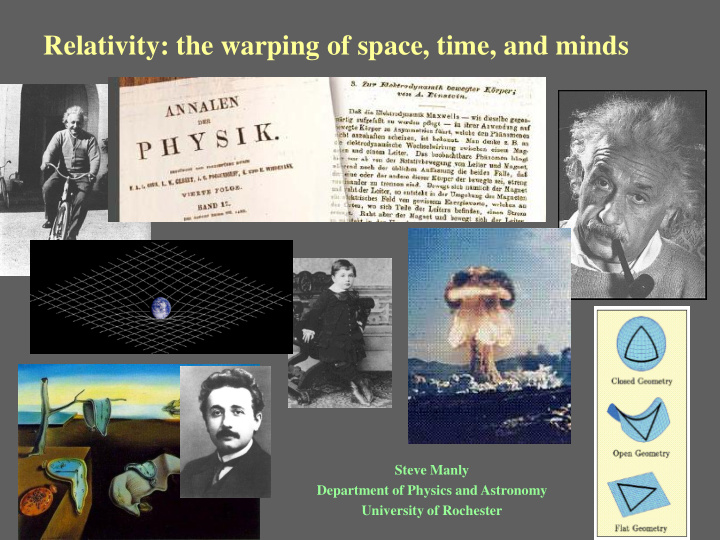



Relativity: the warping of space, time, and minds Steve Manly Department of Physics and Astronomy University of Rochester
What is time?? What is space??
4 mi/hr Speed with respect to you is 4 mi/hr 4 mi/hr 2 mi/hr Speed with respect to you is 2 + 4 = 6 mi/hr
The speed of light is greater for beam I, beam II or beam III? Car moves while passenger shines a flashlight. II V I III Experiment says the speed of light is the same in all directions!!
waves Photo credit: Andrew Davidhazy
Michelson-Morley experiment 1881 – A.A. Michelson in Berlin 1887 - A.A. Michelson and E.W. Morley in US (Case Western) 1907 Nobel Prize in physics Michelson Morley
Weird, huh? What does it mean for the real world? Enter our man Einstein!
Instead of trying to “save the current paradigm”, Einstein bowed before the experiment. What if it is true?? Two postulates: 1) Michelson-Morley is correct. Speed of light is the same in all inertial reference frames 2) Physics is the same in all inertial reference frames Point of view of observer Moving at constant speed
Einstein thought experiment: Consider a beam of light that is emitted from the floor of a train that bounces off a mirror on the ceiling and returns to the point on the floor where it was emitted. v H
Fact: Light is emitted and detected at point A. This fact must be true no matter who makes the measurement!!!! v H A
Sam is on the train H Sam Velocity of light = c c = distance/time c = 2H/T sam T sam = 2H/c
Sally watches the train pass and makes the same measurement. v H sally Light is emitted
v H
Sally is standing still, so it takes two clocks. v H 1 2 sally sally Light returns Light is emitted
Sam Sally Sally sees the light traveling further. If light travels at a constant speed, the same “event” must seem to take longer to Sally than Sam! Time is relative … not absolute!!
From Sally’s point of view Path light Path light takes from takes to mirror to mirror H detector Distance train travels while light is traveling = VT sally 1 2 2 Makes use of Pythagorian theorem D H ( v T ) sally 2
From Sally’s point of view H c = distance/time = 2D/T sally T sally = 2D/c
Sam (on train) Sally (on ground) 2H/T sam = c c = 2D/T sally 2 1 2 2 c H ( v T ) sally T 2 sally 2 2 H 2 1 2 H v T sally T T 2 sam sally 2 2 2 2 2 H 2 H 2 1 v T sally T T T 2 sam sally sally
2 2 2 H 2 H 2 v T T sam sally 2 2 2 1 1 v 2 T T ( 2 H ) sam sally Recall 2H/T sam = c or 2H=cT sam 2 2 2 1 1 v 2 T T ( cT ) sam sally sam 1 2 2 c T T T 2 2 sally sam sam c v 2 v 2 T 1 sally c
Sam (on train) Sally (on ground) 2H/T sam = c c = 2D/T sally 2 1 2 2 c H ( v T ) sally T 2 sally A bit of algebra. This number is >1. It becomes larger as 1 T T v approaches c. sally sam 2 v 1 c
Think about it! Sam and Sally measure the time interval for the same event. The ONLY difference between Sam and Sally is that one is moving with respect to the other. Yet, T sally > T sam The same event takes a different amount of time depending on your “reference frame”!! Time is not absolute! It is relative!
Can this be true?? Experiment says YES! ground plane
Can this be true?? Experiment says YES! ground plane
Less time elapsed on the clocks carried on the airplane ground plane
V=0.98c Lifetime=70 years on spaceship Earth at rest How long does person appear to live to astronomers on earth?
Measure the length of a boxcar where you are on the car. V Measure the length of a boxcar moving by you.
Length is relative, too! Large V V=0
Lorentz transformations y Event at (x,y,z,t) x z
Lorentz transformations y' Event at (x',y',z',t') x' z'
Lorentz transformations v y' y x' x γ(x' z' x vt' ) z y y' How are (x,y,z,t) related to (x',y',z',t')? z z' x ` γ(t' t v ) 2 c
Lorentz transformations v y' y Why is this vitally important for science x' as a whole and x γ(x' z' x vt' ) physics in particular? z y y' How are (x,y,z,t) related to (x',y',z',t')? z z' x ` γ(t' t v ) 2 c
Lorentz transformations v y' y Space and time get all mixed up when you relate observations made from different points of view x' x γ(x' z' x vt' ) z y y' Spacetime How are (x,y,z,t) related to (x',y',z',t')? z z' x ` γ(t' t v ) 2 c
v y' All other things that can be observed must have “relativisitic y transformations”, too! x' x z γ(x' x vt' ) z' p y y' mv γ(p' p vE' /c) z z' p' γ(E' E /c v ) 2 c x ` γ(t' E=mc 2 t v ) 2 c
Recommend
More recommend